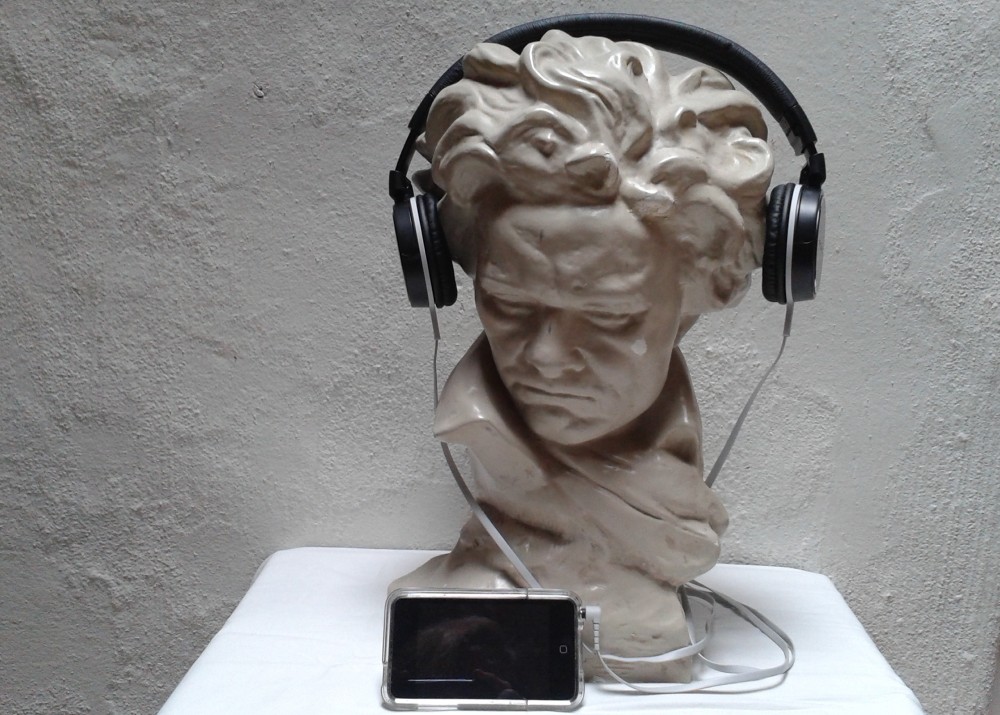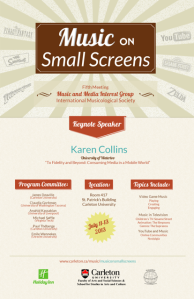The second MaM conference took place at the Institute for Musicology and Media Studies/Institut für Musikwissenschaft und Medienwissenschaft, Humboldt University, Berlin, on 26-27 June 2010. There were three keynote lectures (Helga de la Motte, Philips Auslander and Michael Saffle), and 23 other presentations. Papers were grouped into themed sections: Virtual Worlds, Performance and Technology, Politics, Film and Radio. The presentations included work by three research groups, from Belgium, Italy and Berlin/Potsdam respectively, and 14 participants attended the workshop “Multimedia Art and Performance” (this outside the five instructors and professional musicians involved). Speakers were from Belgium, Canada, France, Germany, Italy, the Netherlands, Northern Ireland, England and the United States. There were 60 registered participants at the conference.
The meeting was funded by the DFG, the European Network for Musicological Research and the Humboldt-Universitäts-Gesellschaft.
Friday, 25 June
9am – 1pm
Workshop “Multimedia Art and Performance” with Iñigo Giner Miranda (D/ES) und Philip Auslander (USA)
2pm – 3pm
Welcome:Tobias Plebuch and Hermann Danuser, (Humboldt University); Emile Wennekes, MaM
Keynote: Helga de la Motte (Technische Universität Berlin), “Multi – Intermedialität: Veränderungen des Musikbegriffs”.
Iñigo Giner Miranda (Universität der Künste, Berlin), “Tratado de imagines for Violin, Clarinet and Piano, video images by Iñigo Giner Miranda, Man Ray, Joris Ivens, and Fernand Léger”;
Minkyu Kim (Hochschule für Musik, Freiburg), “Halluzination for Violin, Clarinet and Piano, video images by Peter Weiß”.
Section I: Virtual Worlds
Melanie Fritsch (Universität Bayreuth), “Worlds of Music: Strategies for Creating Music-Based Experiences in Video Games”;
Thorsten Hindrichs (Johannes Gutenberg-Universität Mainz), “From Dungeons & Dragons to Brütal Legend – Virtuality and heavy metal culture”;
Emile Wennekes (Utrecht University), “At the intersection of two worlds: Live concerts within Second Life”;
Michael Liebe (Universität Potsdam) / Georg Spehr (Universität der Künste Berlin) / Dennis Mathei (Ruhr-Universität Bochum), “Spiel die Musik”.
Saturday, 26 June
9 – 9:30am
Gianmario Borio / Elena Mosconi (University of Pavia), “The research group Worlds of AudioVision”.
Section II: Performance and Technology I
Irene Kletschke (Universität der Künste Berlin), “Video clip and the Web 2.0”;
Felipe Hickmann / Pedro Rebelo (Sonic Arts Research Centre, Queen’s University Belfast), “Audiovisual strategies for rendering presence in networked music performance”.
Volker Straebel (Technische Universität Berlin): “Unikat oder Reproduktion. Strategien des Performativen bei medienspezifischen Künstlerschallplatten”
Jens Papenburg / Tobias Plebuch (Humboldt Universität), “Shaping His Master’s Voice: Post-Production of Classical and Popular Music”.
1 – 2pm
Keynote Philip Auslander (Georgia Tech), “Jazz Improvisation as a Social Arrangement”.
Section III: Performance and Technology II
Knut Holtstäter (Universität Bayreuth), “I’ve got the world on a string – der Sänger und die Medien”;
Falk Hübner (Leiden University),”The musician as theatrical performer – a reductionist perspective”;
Lydmila Symonova (Universität Freiburg),”Verhältnis vom Sichtbaren und Hörbaren in der Produktion des 1. Zustandes von Wolfgang Rihms Séraphin mit Video-Bildern von Klaus vom Bruch”.
Section IV: Politics
David Kasunic (Occidental College), “Great Expectations: ‘Rickrolling’ and the Obama Presidential Campaign”;
Gayle Wald (George Washington University), “Soul! TV: Music and Media in the Era of Black Power”.
Sunday, 27 June
Section V: Film I
Alexis Luko (Carleton University): “For Whom the Bell Tolls: Sound Effects in the Films of Ingmar Bergman”;
Elizabeth McLain (Virginia Polytech): Mediatizing Nature and Culture: Ovchinnikov’s Soundtrack for “Ivan’s Childhood”;
Allegra Kuklowsky (University of Paris IV, Sorbonne): “Opening Credit Sequences in Motion Picture Film Scores: an Examination of Compositional Trends”;
Melissa Wong (University of Cambridge): “All’s Fair in Love and War: Herrmann vs. Addison in the Case of Hitchcock’s Torn Curtain”.
1 – 2pm
Keynote Michael Saffle (Virginia Tech), “Lisztomania: The Real Musical(ized) Story”.
Section VI: Radio
Mauro Fosco Bertola (Universität Heidelberg), “Medium und Botschaft: Die musikalische Inszenierung einer „zivilisatorischen Mission“ Roms im italienischen Rundfunk 1929”;
Kristin Van den Buys, Lien De Cang, Lieselotte Goessens and Katia Segers, (Vrije Universiteit and Erasmus University College), “Linking arts initiative and artistic policy: a history of institutionalisation, financing and artistic programming of the Belgian ‘factory of sounds’ – the National Radio Institute and its orchestra – between 1929 and 1960”;
Simone Christine Münz (Universität Göttingen), “The Role of Music in Radio Broadcasting from the Cuban exile community in Miami/ Florida to Cuba”.
Section V: Film II
Orlene Denice McMahon (University of Cambridge), “Cellular (Film Music) Composition: Jean-Claude Éloy’s score for Jacques Rivette’s ‘La religieuse’ (1966)”;
Peter Niedermüller (Johannes Gutenberg-Universität Mainz), “Beyond Hollywood. Music, Sound and Signs in David Lynch’s Blue Velvet”.
5 – 6pm
Closing discussion

